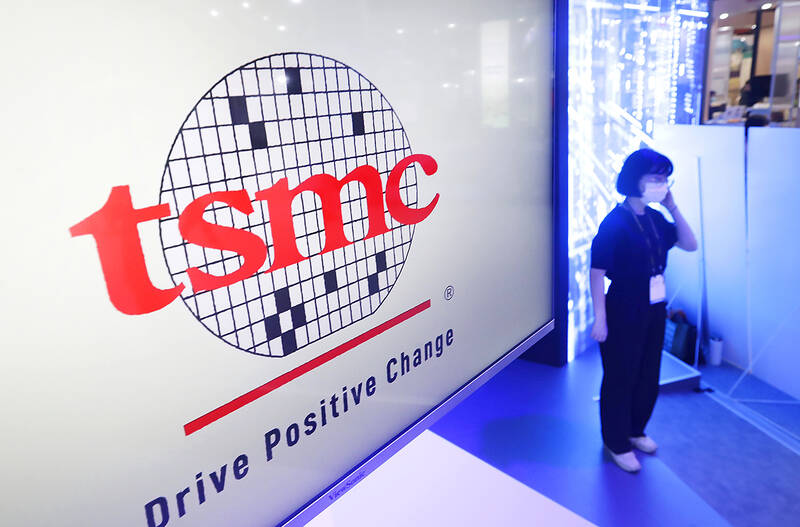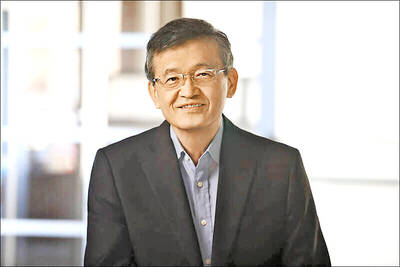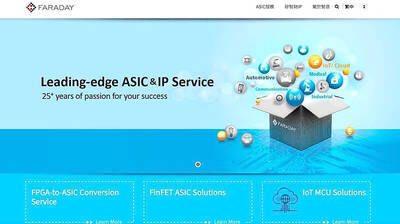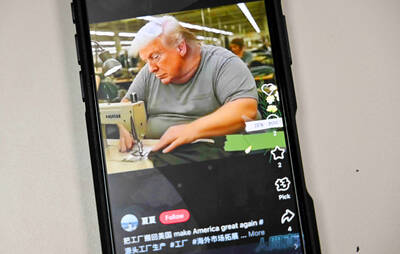Taiwan Semiconductor Manufacturing Co’s (TSMC, 台積電) quarterly sales topped estimates, reinforcing investor hopes that the torrid pace of artificial intelligence (AI) hardware spending would extend into this year.
The go-to chipmaker for Nvidia Corp and Apple Inc reported a 39 percent rise in December-quarter revenue to NT$868.5 billion (US$26.35 billion), based on calculations from monthly disclosures. That compared with an average estimate of NT$854.7 billion.
The strong showing from Taiwan’s largest company bolsters expectations that big tech companies from Alphabet Inc to Microsoft Corp would continue to build and upgrade datacenters at a rapid clip to propel AI development.

Photo: Chiang Ying-ying, AP
Growth accelerated for TSMC last month, capping 34 percent revenue growth for last year. That compares with TSMC’s official target of a 30 percent annual rise, although that outlook was expressed in US dollar terms. The world’s largest maker of advanced chips has been one of the biggest beneficiaries of a global race to develop AI.
TSMC’s market value nearly doubled last year, and it now trades in the US at a valuation close to US$1.1 trillion. However, some investors worry about when the AI boom would peter out. While TSMC’s revenue beat, it was just 1.6 percent higher than the average projection and fell short of the most bullish analyst expectations.
More bearish market observers point to potential over-building, bottlenecks to development such as power shortages, and the persistent absence of a killer AI app or service that would use up all of that server capacity.
The company’s gross margin is likely to expand to a two-year high of 58 percent or more, Bloomberg analyst Charles Shum said.
Four areas merit attention, Shum said.
First, the outlook for chip-on-wafer-on-substrate advanced-packaging capacity build and revenue, which is likely to give insight into the expected strength for AI chip demand in the coming twelve to eighteen months, he said.
Second, progress on the US Arizona fab’s ramp-up, which is critical to meeting the onshoring chipmaking needs of Apple, Nvidia and others, he said.
Third, potential margin pressure from weaker demand in 7-nm, 16-nm and larger mature nodes, he said.
Finally, capital-spending plans this year, which would signal TSMC’s confidence in the uptake of its next-generation N2 node, he added.
The US has also erected a web of restrictions to curtail the flow of Nvidia’s most powerful chips to China, with uncertain longer-term ramifications for TSMC’s key customer.
Morgan Stanley expects TSMC to project annual sales growth of low-20 percent in dollar terms. “TSMC usually guides conservatively at the beginning of the year, and then over-delivers,” analyst Charlie Chan wrote, adding that the company raised its outlook for growth over the course of last year and might again be starting from a more conservative position at the start of a new year.

Intel Corp chief executive officer Lip-Bu Tan (陳立武) is expected to meet with Taiwanese suppliers next month in conjunction with the opening of the Computex Taipei trade show, supply chain sources said on Monday. The visit, the first for Tan to Taiwan since assuming his new post last month, would be aimed at enhancing Intel’s ties with suppliers in Taiwan as he attempts to help turn around the struggling US chipmaker, the sources said. Tan is to hold a banquet to celebrate Intel’s 40-year presence in Taiwan before Computex opens on May 20 and invite dozens of Taiwanese suppliers to exchange views

Application-specific integrated circuit designer Faraday Technology Corp (智原) yesterday said that although revenue this quarter would decline 30 percent from last quarter, it retained its full-year forecast of revenue growth of 100 percent. The company attributed the quarterly drop to a slowdown in customers’ production of chips using Faraday’s advanced packaging technology. The company is still confident about its revenue growth this year, given its strong “design-win” — or the projects it won to help customers design their chips, Faraday president Steve Wang (王國雍) told an online earnings conference. “The design-win this year is better than we expected. We believe we will win

Chizuko Kimura has become the first female sushi chef in the world to win a Michelin star, fulfilling a promise she made to her dying husband to continue his legacy. The 54-year-old Japanese chef regained the Michelin star her late husband, Shunei Kimura, won three years ago for their Sushi Shunei restaurant in Paris. For Shunei Kimura, the star was a dream come true. However, the joy was short-lived. He died from cancer just three months later in June 2022. He was 65. The following year, the restaurant in the heart of Montmartre lost its star rating. Chizuko Kimura insisted that the new star is still down

While China’s leaders use their economic and political might to fight US President Donald Trump’s trade war “to the end,” its army of social media soldiers are embarking on a more humorous campaign online. Trump’s tariff blitz has seen Washington and Beijing impose eye-watering duties on imports from the other, fanning a standoff between the economic superpowers that has sparked global recession fears and sent markets into a tailspin. Trump says his policy is a response to years of being “ripped off” by other countries and aims to bring manufacturing to the US, forcing companies to employ US workers. However, China’s online warriors